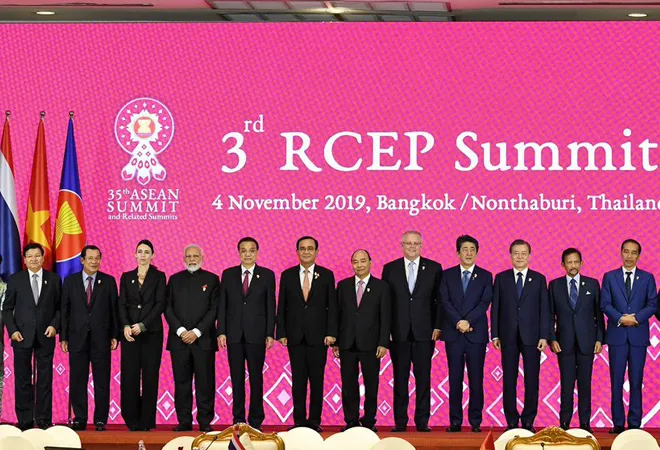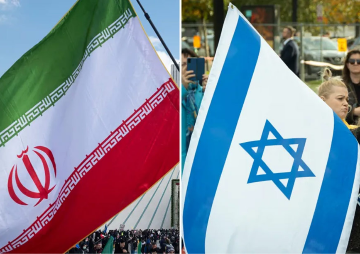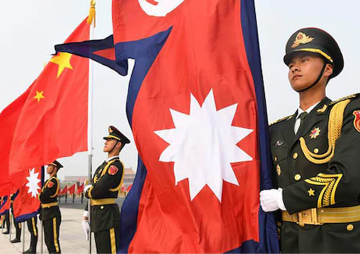On November 15, 2020, as 15 nations - ASEAN 10, Australia, China, Japan, New Zealand and South Korea - signed the Regional Comprehensive Economic Partnership (RCEP), the clamour around India’s move of walking away from the mega-trade deal became increasingly audible.
This despite the fact that the new trading bloc, time and again, has clarified that the exit does not imply a closure of the doors for India to return to the negotiating table. Rather, the partner nations always insisted on Indian inclusion in the trade deal, the rationales of which are quite apparent, explained in the latter part of this article.
However, at this point, what seems extremely quizzical is that the RCEP has been signed with the “global bully” China being an important member of the bloc. This apparently seems beyond comprehension from the perspective of many of the RPCs (RCEP participating countries). However, China’s presence in RCEP fits absolutely well with its market imperialistic designs with which it conceived of its Belt and Road Initiative (BRI).
The recent past of China has been shrouded with its misgivings. While the US-China trade war witnessed its winners and losers, China has often been projected as a force whose designs of invading the input markets of the global south and the product markets of the global north are obvious.
The last year witnessed several other developments: apprehensions with China on the origins of the pandemic, misadventures at the Indo-China border, its exploits in the South China Sea against some members of the ASEAN, the wolf-warrior diplomacy, and its open threat to Australia for the latter’s call for an independent investigation on the origins of Covid-19.
At the same time, while there has been a call for strengthening the QUAD (Australia, India, Japan and US) in the Indo-Pacific in an attempt to counter the Chinese exploits.
Despite such circumstances, China’s participation on the RCEP bloc indicates that several other member nations have decoupled geopolitics and economic interests as a policy imperative.
But, not India. Rather the existence of China in the bloc is a critical decision variable for India as far as the RCEP is concerned.
There is no doubt that the skirmishes at the border have soured the India-China relations to the extent that a “decoupling” of the economic and the geopolitical relations does not seem to be in the horizon.
Yet, there seems to be a host of voices within and outside India that feels that India has missed out the bus by not being a member of the mega-trade deal. Earlier, many economists stated that the RCEP will help Indian MSMEs to integrate effectively into the ASEAN value chain. Lately, some analysts have put forward the thesis that India would have attracted greater investment as not only our goods and services would have had preferential access to this large and growing market of the RPCs (RCEP participating countries), but the flight of capital and shifting supply chains from China due to US-China trade war and Covid-19 could also have benefited India.
Some others have criticised India’s withdrawal from the mega-trade deal from the perspective of geostrategic and geopolitical consequences: it is perceived that the RCEP can be the perfect instrument for China to enhance its dominance on the world economy, which will help it garner and exert more political influence.
Let me take up each of these points one by one for assessments.
First of all, the very idea that Indian MSMEs can integrate effectively into ASEAN value chain is a working hypothesis, and not really backed by any data or empirical analysis. Rather the possibility of things working in the opposite direction seems more probable given the existing inefficiencies and lack of competitiveness of this sector as compared to the ASEAN or in other nations in the RPCs. This has emerged due to inefficiencies in the labour markets fragmented and incapacitated by labour laws, low-average productivity due to inefficient production processes, and high transaction costs of doing business created by fragmented markets.
This inefficiency is not limited to factor markets but extends to product markets. It is disappointing to note that even after three decades of economic reforms, Indian manufacturing is still scared to face the vagaries of competition brought about by international trade.
Unimplemented policy reforms in the product and the factor markets are responsible for that. Though GST introduction was thought of to be a major step in this regard by rationalising supply-chains and removing the fragmented nature of the markets, the present structure is complicated and afflicted by the high cost of compliance.
Even hedging cost in India in commodity trade is higher than any of the RPCs due to existence of commodity transaction taxes in the commodity exchanges: no other nation in the bloc has such a tax.
In the given scheme of things with high transaction costs, if India has to attract investments from the RPCs, the enabling business conditions proposed through reforms are of utmost need. There is no doubt that by infusing business competitiveness in the economy through policy reforms, many of the challenges brought about by the RCEP can be converted to opportunities. But presently that is not the case.
In terms of ease-of-doing-business index, with the exception of Cambodia, Lao PDR and the Philippines, all other RPCs rank higher than India and hence can boast of better business conditions for attracting investments in a level-playing field. Therefore, it is highly-unlikely that RCEP will be beneficial either from the “Make in India” or “Atmanirbhar Bharat” perspective. Therefore, RCEP will not be helpful for India to attract the capital flight or the shifting supply-chains from China due to the trade war or the pandemic.
Now comes the second point. As far as the geostrategic arguments are concerned, there is no doubt that the RCEP becomes the biggest and the most significant deal happening, considering the diminishing importance of TPP after the US’ exit. Japan, Singapore and ASEAN reckon that a new world economic order may indeed be created, and therefore have been putting pressure on India for the deal. Now the question is: can one really uphold broader geostrategic interests by sacrificing its own domestic economic interests?
In any case, India records bilateral trade deficits with the ASEAN bloc as a whole, so do the remaining five RPCs. The trade deficits have only increased over time. China’s contribution to the trade deficit has been the highest, despite some late declines in 2019-20.
Some estimates state that there may be gains in GDP, trade and investment through the RCEP for India, but the overall economic well-being will either have no impact or will actually have a negative impact.
If such analyses and figures are to be believed, then the costs of getting into the RCEP should be considered first rather than the gains.
Some other analyses infer that India’s imports from member countries would increase, though the same will decline from non-member countries thereby revealing significant trade shifting from non-member to member nations.
This implies that with a preferential treatment through the RCEP to a few nations, India will actually create a trade barrier with some other trading partners. This may result in long-term losses from trade. More critically, there is not a single analysis that has estimated the impacts of the RCEP on the value-chain.
How can a big decision be taken without getting into a comprehensive cost-benefit analysis, just because some analysts perceive that some short-term geostrategic gains can be brought about by the RCEP? That too, at a time when India’s primary demand for greater market access in services with regard to Mode 4 is yet to be met.
India’s resistance to the RCEP related to goods trade with China can only partially be offset with greater market access in services with regard to Mode 4. However, this issue still remains open.
RPCs’ positions on India
Believe it or not, India is a force to reckon with in the Indo-Pacific. India’s withdrawal makes RCEP lose a large part of its sheen.
To any external player, India enjoys the demographic dividend which is slated to last till 2055 with an existing population base of 1.37 billion, whose income is increasing at 6-8 per cent over the last few years, despite its recent setbacks of negative growth due to the lockdown.
The economy has grown organically, driven by consumption and demand. No RPC can boast of such a lucratively growing market. Therefore, it is quite logical that from a long-term market growth perspective, RPCs will always want India to join the RCEP. Economic factors play a bigger role here than the geostrategic ones.
But, it is not for the world to decide on India’s priorities. India needs to get its house in order first, comprehend the benefits and costs and then make its own tryst with destiny.
This commentary originally appeared in India Today.
The views expressed above belong to the author(s). ORF research and analyses now available on Telegram! Click here to access our curated content — blogs, longforms and interviews.




 PREV
PREV


